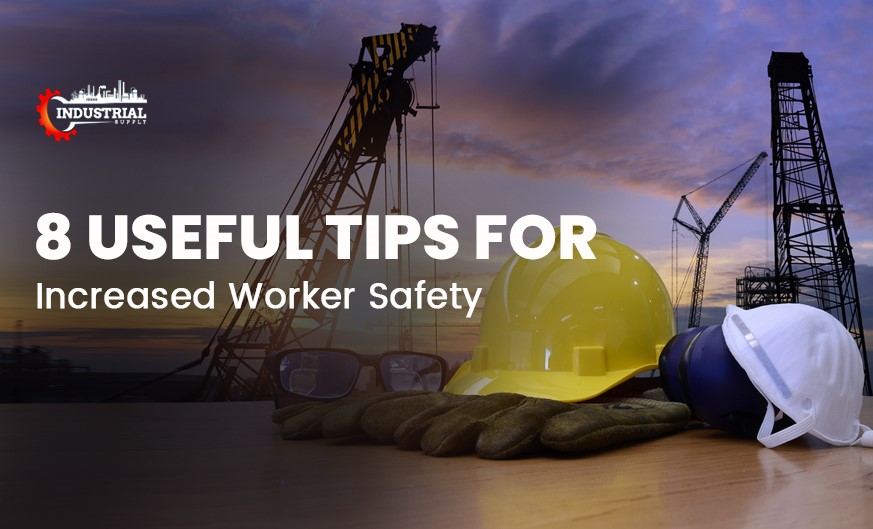Any organization’s first priority should always be worker safety. Workplace accidents and injuries not only risk the lives of staff members, but they also have a major effect on productivity, morale, and overall business operations. As an employer or manager, it is critical that you establish a culture of safety by establishing effective safety rules and processes. Establish thorough safety policies and procedures that clarify staff expectations. To maintain compliance, ensure that all employees have knowledge of these regulations and that they are frequently trained on security measures. This post will go over eight helpful recommendations for improving worker safety and creating a safe and productive work environment. Visit our Site: industrialsuply.com
Conduct Regular Safety Training
· Create and Enforce Safety Policies
· Promote a Safety Culture
· Regularly Inspect and Maintain Equipment
· Implement Proper Ergonomics
· Provide Personal Protective Equipment (PPE)
· Establish Emergency Response Protocols
· Regularly Assess and Review Safety Measures
Conduct Regular Safety Training:
It is essential to provide ongoing safety training to employees to ensure they are aware of potential hazards and know how to prevent accidents. Ensure that all workers receive proper training for the tasks they are performing. This includes training on machinery, equipment, and safety procedures to prevent accidents and injuries. This can include training on proper use of equipment, emergency procedures, and general safety protocols. Proper training is imperative to educate employees about potential hazards and equip them with necessary safety skills. Conduct regular safety training sessions that cover topics such as first aid, fire safety, proper use of equipment, and safe work practices. Ensure your training program is well-documented, interactive, and caters to various learning styles for maximum effectiveness.
Create and Enforce Safety Policies:
Develop clear and comprehensive safety policies that outline expectations and guidelines for employees. Ensure that these policies are communicated effectively and consistently enforced to ensure compliance.
Develop comprehensive safety policies specific to your workplace and industry. These policies should cover all potential risks and hazards, including protective equipment requirements, emergency procedures, ergonomic guidelines, and general safety protocols. Enforce strict adherence to these policies and conduct regular audits to ensure compliance throughout the organization.
Promote a Safety Culture:
Encourage a culture of safety within the organization by promoting open communication about safety concerns and promoting the reporting of near misses or potential hazards. Safety should not be viewed as an afterthought or a mere box to be ticked. Create a safety-conscious culture by involving employees in safety planning, decision-making, and problem-solving. Encourage them to report near-misses and potential hazards, and reward proactive safety behavior. By fostering a culture of safety, you will increase employee awareness and engagement, leading to a safer work environment.
Regularly Inspect and Maintain Equipment:
Regular inspections and maintenance of equipment are essential to ensure the safety of workers and prevent accidents. Here are some steps to implement a schedule for routine checks and repairs. Make a comprehensive list of all the machinery and equipment that requires regular maintenance and inspections. This includes any tools, vehicles, machines, or electrical equipment used in your workplace. Access the needs of each piece of equipment and determine how often it should be inspected. High-risk equipment may require more frequent inspections, while lower-risk items may need less frequent checks. Create a detailed checklist that outlines all the critical components and functions to be checked during inspections. This checklist should cover all safety aspects, such as breakages, leaks, loose parts, worn-out components, or signs of wear and tear.
Implement Proper Ergonomics:
Provide ergonomic assessment and training to help employees maintain proper posture and reduce the risk of musculoskeletal disorders. Adjust workstations, chairs, and equipment to ensure they are ergonomically designed and suitable for each employee’s needs. Poor ergonomics can lead to musculoskeletal disorders and work-related injuries. Assess workstations and job tasks for ergonomic risks and make necessary adjustments. Invest in ergonomic furniture, tools, and equipment to promote correct posture, reduce strain, and minimize repetitive motion injuries. Educate employees on proper body mechanics and encourage regular breaks to relieve any physical stress.
Provide Personal Protective Equipment (PPE):
Identify the need for personal protective equipment based on job roles and potential hazards. Provide appropriate PPE such as safety glasses, gloves, helmets, or earplugs, and ensure employees are trained on proper usage and maintenance. Identify specific job tasks that require personal protective equipment (PPE) and provide the necessary gear to employees. This may include safety goggles, gloves, earplugs, helmets, or respirators. Regularly check and replace damaged or ineffective PPE and ensure employees are fully trained on its proper use, storage, and maintenance. Make sure that workers have access to and use the necessary personal protective equipment, such as helmets, gloves, safety goggles, and earplugs. Regularly check and replace worn-out or damaged PPE.
Establish Emergency Response Protocols:
Develop and communicate clear emergency response protocols, including evacuation procedures, designated assembly points, and methods of reporting incidents. Conduct regular drills and exercises to ensure employees are familiar with these protocols and can respond effectively in case of an emergency. Prepare your workforce for emergencies by developing and practicing emergency response protocols. Conduct fire drills, evacuation exercises, and ensure all employees are familiar with emergency exits, assembly points, and alarm systems. Keep first aid kits well-stocked, ensure employees are trained in first aid, and appoint designated individuals to respond to emergencies professionally.
Regularly Assess and Review Safety Measures:
Conduct regular inspections and assessments to identify any new safety risks or areas for improvement. Review safety measures, policies, and training programs regularly to ensure their effectiveness and make necessary adjustments to maintain a safe work environment. Worker safety is an ongoing process that requires constant monitoring and improvement. Regularly review safety procedures, policies, and incidents to identify any gaps or areas for improvement. Involve employees in safety discussions, seek feedback and suggestions, and implement changes based on their input. Collaboration and continuous evaluation will foster a safe workplace environment. Continually reviewing and updating safety procedures ensures that they stay up-to-date with new regulations and potential hazards. Consult with experts in the field to ensure safety procedures are effective.





